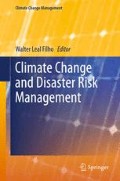Abstract
Changes in precipitation, temperature, drought, and sea level rise a rise in sea level are increasingly being seen as affecting the world’s ecosystems and natural resource base. Recent reports from the Intergovernmental Panel on Climate Change have provided ample evidence of the importance of climate variability in the changing nature of natural resource ecology, as well as the vulnerability of communities and their livelihoods. Climate variability and the rise in the incidents of extreme events and disasters like cyclones are major threats to the coastal and marine ecosystems in the Indian subcontinent, e.g. low-lying islands and coastal regions, some of which are already facing partial submergence, resulting in shoreline changes. Most of the coastal ecosystems in the South Asian region have a very high population density and are dependent on an agro-economy, whilst increasing changes to the weather have often led to adverse impacts on the local eco-diversity. Ecosystem-dependent communities are particularly vulnerable where single-crop agriculture, fishing and harvesting of other local resources are practised. These in turn could be adversely affected by changes such as sea level rise, increase in salinity, changing patterns of rainfall, and an increase in moisture content in the atmosphere leading to increasing incidences of vector-borne diseases. Addressing traditional knowledge systems with new research ideas and the development of innovative technologies is the need of the hour in order to provide a suitable adaptation response in the face of adverse climate impacts and natural disasters. The paper discusses approaches and trends for enhancing the coping capacity of coastal communities through two cases in India from the Sundarbans in West Bengal and Tamil Nadu. The paper also throws light on integrating national/state policies and programmes for mainstreaming climate adaptation practices in development planning.
Access this chapter
Tax calculation will be finalised at checkout
Purchases are for personal use only
References
Loucks C, Barber-Meyer S, Hossain MAA, Barlow A, Chowdhury RM (2010) Sea level rise and tigers: predicted impacts to Bangladesh’s Sundarbans mangroves. Clim Change 98:291–298
McGranahan G, Balk D, Anderson B (2007) The rising tide: assessing the risks of climate change and human settlements in low elevation coastal zones. Environ Urb 19(1):17–37
MoES (2010) Ministry of Earth Sciences annual report. Government of India , New Delhi, p 98. http://www.dod.nic.in/AnnualReport/AR2009-2010.pdf
MoEF (1989) Sunderban biosphere reserve. Project Document No. 10, Ministry of Environment and Forests, Government of India, New Delhi. http://www.sadepartmentwb.org/Sundarban_Biosphere.htm
MSSRF (2009) Climate literacy for sustainable food and water security. Report of a National Workshop on Role of Gyan Choupals in spreading climate literacy and building sustainable food and water security systems, MS Swaminathan Research Foundation, Chennai, No. PR/09/73, p 60
NAPCC (2008) National action plan on climate change. Prime Minister’s Council on Climate Change, Government of India Publication, New Delhi, p 52
Nicholls RJ, Leatherman SP (1995) Potential impacts of accelerated sea level rise on developing countries. J Coastal Res 14:324
Parry ML, Canziani OF, Palutikof JP, Van der Linden PJ, Hanson CE (2007) Climate change 2007, impacts , adaptation and vulnerability. Contribution of working group II to the fourth assessment report of the intergovernmental panel on climate change. Cambridge University Press, Cambridge, p 976
Patterson JK, Samuel D (2004) Effect of climate change on the loss of Lactarius lactarius fishery and dependent fishermen in the southeast coast of India. Internal technical report submitted to WWF, New Delhi, p 32
Patwardhan A, Narayanan K, Parthasarathy D, Sharma U (2003) Impacts of climate change on coastal zones. In: Shukla PR, Sharma SK, Ravindranath NH, Garg A, Bhattacharya S (eds) Climate change and india—vulnerability assessment and adaptation. Universities Press, Hyderabad, pp 326–359
Rupa Kumar K, Sahai AK, Kumar KK, Patwardhan SK, Mishra PK, Revadekar JV, Kamala K, Pant GB (2006) High Resolution climate change scenarios for India for the 21st century. Curr Sci 90(3):334–345
Shukla PR, Sharma SK, Ravindranat NH, Garg A, Bhattacharya S (2003) Climate change and India: vulnerability assessment and adaptation. Universities Press, Hyderabad, p 462
Stainforth DA, Aina T, Christensen C, Collins M, Faull N, Frame DJ, Kettleborough JA (2005) Uncertainty in predictions of the climate response to rising levels of greenhouse gases. Nature 433:403–406
TERI (1996) The economic impact of a one metre sea level rise on the Indian coastline: methods and case studies. Tata Energy Research Institute, submitted to the Ford Foundation, New Delhi, No. 93/GW/52
Thakkar H (2009) India’s national action plan on climate change: a civil society view. South Asia Network on Dams, Rivers and People Publication, New Delhi, p 56
UNDP (2010) A toolkit for designing climate change adaptation initiatives. United Nations Development Programme, Bureau of Development policy, United Nations Development Programme, p 62
World Bank (2006) India—building capacities for public private partnerships. Energy and Infrastructure Unit and Finance and Private Sector Development Unit, p 62
WWF (2005) An overview of glaciers, glacier retreat and its subsequent impacts in the Nepal, India and China. WWF Nepal Program, Kathmandu, p 67
WWF (2010) Sundarbans: future imperfect—climate adaptation report. Amanda, WWF India Publication, New Delhi, p 30
WWF International (2005) Are we putting our fish in hot water? WWF climate change programme, WWF international report, Gland, p 15
Xu J, Grumbine RE, Shreshtha A, Eriksson M, Yang X, Wang Y, Wilkes A (2009) The melting Himalayas: cascading effects of climate change on water, biodiversity and livelihoods. Conserv Biol 23:520–530
Author information
Authors and Affiliations
Corresponding author
Editor information
Editors and Affiliations
Rights and permissions
Copyright information
© 2013 Springer-Verlag Berlin Heidelberg
About this chapter
Cite this chapter
Rao, P. (2013). Building Climate Resilience in Coastal Ecosystems in India: Cases and Trends in Adaptation Practices. In: Leal Filho, W. (eds) Climate Change and Disaster Risk Management. Climate Change Management. Springer, Berlin, Heidelberg. https://doi.org/10.1007/978-3-642-31110-9_21
Download citation
DOI: https://doi.org/10.1007/978-3-642-31110-9_21
Published:
Publisher Name: Springer, Berlin, Heidelberg
Print ISBN: 978-3-642-31109-3
Online ISBN: 978-3-642-31110-9
eBook Packages: Business and EconomicsEconomics and Finance (R0)

